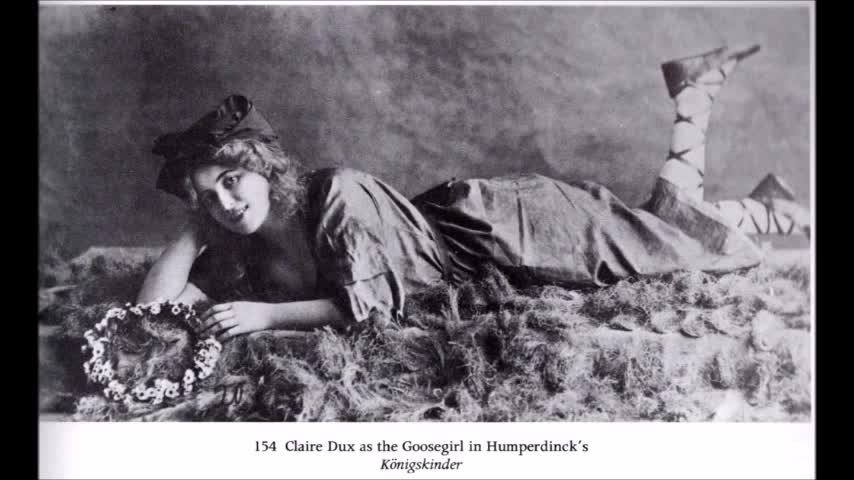Premium Only Content

The Record of Singing (EMI) 1979 Record 11 Volume 2 1914 - 1925
1 Elisabeth Schumann 1888-1952–
Der Freischütz (Act 3) - Trübe Augen. Recorded 1915, In German
Composed By – Weber
2 Berta Kiurina 1881-1933–
Norma (Act 1) - Keusche Göttin (Casta Diva). Recorded 1920, In German.
Composed By – Bellini
3 Lola Artôt de Padilla 1880-1933–
Don Giovanni (Act 1) - Schmäle, Tobe, Aus (Batti, Batti). Recorded 1916, In German
Composed By – Mozart
4 Lola Artôt de Padilla–
Don Giovanni (Act 2) - Wenn Du Fein Fromm Bist (Verdrai Carino). Recorded 1916, In German
Composed By – Mozart
5 Claire Dux 1885-1967–
Mignon (Act 2) - Dort Bei Ihm Ist Sie Jetzt (Elle Est Aimee). Recorded August, 1911, In German
Composed By – Thomas
6 Vera Schwarz 1884-1964–
Paganini (Act 2) - Liebe, Du Himmel Auf Erden. Recorded 1925, In German.
Composed By – Lehar
7 Maria Ivogün 1891-1987–
Rigoletto (Act 1) - Teurer Name (Caro Nome). Recorded 1917, In German.
Composed By – Verdi
8 Maria Jeritza 1887-1982–
Ariadne Auf Naxos - Es Gibt Ein Reich. Recorded 1913, In German.
Composed By – R. Strauss
9 Lotte Lehmann 1888-1976–
Tosca (Act 2) Nur Der Schönheit (Vissi D'arte). Recorded February, 1924, In German
Composed By – Puccini
10 Margarete Arndt-Ober 1885-1971–
Le Prophete - Church Scene. Recorded 1911, In German.
Composed By – Meyerbeer
11 Ottilie Metzger 1878-1943–
In Questa Tomba Oscura. Recorded 1908, In German
Composed By – Beethoven
Orchestra – Hamburg State Theatre Orchestra
12 Anka Horvat–1888-c 1921
Il Trovatore (Act 2) - Lodernde Flammen (Stride La Vampa). Recorded 1916, In German.
Composed By – Verdi
13 Sabine Kalter 1889-1957–
Le Prophete (Act 5) - Air De Baal. Recorded May, 1923, In German.
Composed By – Meyerbeer
14 Emmi Leisner 1885-1958 – Odysseus - Ich Wob Dies Gewand. Recorded 1924, In German.
Composed By – Bruch
The Record of Singing is a compilation of classical-music singing from the first half of the 20th century, the era of the 78-rpm record.
It was issued on LP (with accompanying books) by EMI, successor to the British company His Master's Voice (better known as HMV) — perhaps the leading organization in the early history of audio recording.
The project was accompanied initially by two illustrated books, containing singers' biographies and appraisals, which were published in London, by Duckworth, in the late 1970s. It covers the period running from circa 1900, when the earliest recordings were made, through until the early 1950s, when the last 78-rpm records were produced. Singers are divided into groups arranged according to national 'schools' and fach or voice type. In practice, this means that there are separate Italian, German, French, Anglo-American and East European classifications.
Origins
The original idea for the series came from the collector Vivian Liff, who chose the recordings used in the first two volumes, almost all of which came from the Stuart-Liff Collection, as well as the photographs of the singers which were published in the books that accompanied volumes 1 and 2 of the project. Michael Scott was asked to write these two books. They contained brief singers' biographies, too and featured a critical (sometimes controversial) commentary about their accomplishments, are gleaned from certain discs they had made. Bryan Crimp of EMI was responsible for the transfers of the original recorded material to LP. Keith Hardwick, however, was responsible for the transfers, etc., on the final two volumes of the survey (which were not accompanied by books).
Publication on LPs
EMI first released the collection on vinyl LP (long-playing) records.
Volume 1 first appeared in 1977, with a second edition in 1982 including corrections to the pitch of many of the recordings. The supplement also appeared around 1982. Volume 2 was published in 1979. Volume 3 and Volume 4 were released around 1984 and 1989 respectively.
The complete set was on 47 discs. Volumes 1, 2 and 3 each occupied 13, with Volume 4 having 8 discs. The original intention was apparently to produce 12 LPs per volume; but the selection of singers included in Volume 1 proved controversial, and an extra record (entitled a 'Supplement') was added to partly correct oversights. Volumes 2 and 3 were then assigned 13 records each.
Compact disc.
The collection was published with extensive documentation, including the numbers of the original recordings and full biographies of the singers.
The first two volumes were accompanied by books by Michael Scott:
• The Record of Singing to 1914, London, Duckworth, 1977, ISBN 978-0-7156-1030-5
-
 1:10
1:10
KMGH
3 years agoA record day
92 -
 0:28
0:28
vlee66
4 years agoOld record player
139 -
 1:57
1:57
WXYZ
4 years agoRecord warm weekend
210 -
 15:12
15:12
Clownfish TV
15 hours agoVideo Games WILL Drop DEI, Too. Just Wait.
1.55K4 -
 15:17
15:17
Melonie Mac
18 hours agoFemale "Pastor" Lectures Trump with Abomination Sermon
2.92K15 -
 11:56
11:56
IsaacButterfield
1 day ago $0.14 earnedYou're Racist If You Don't Marry Your Cousin
2.28K2 -
 8:11
8:11
MichaelBisping
21 hours agoBISPING Reacts: 'Sign me UP!!' Charles Oliveira CALLS OUT Max Holloway for BMF TITLE FIGHT!
1.75K1 -
 12:38
12:38
NC Dirt Hunter
1 day agoIncredible Civil War relic sticking right out of the ground! Metal Detecting an old plantation.
1.86K2 -
 44:36
44:36
TheTapeLibrary
16 hours ago $1.91 earnedThe DARK Truth About the Pollock Family Tragedy
9.2K11 -
 1:11:01
1:11:01
The Charlie Kirk Show
9 hours agoTHOUGHTCRIME Ep. 70 — Seatgate? Best Executive Orders? Panda Express?
111K14